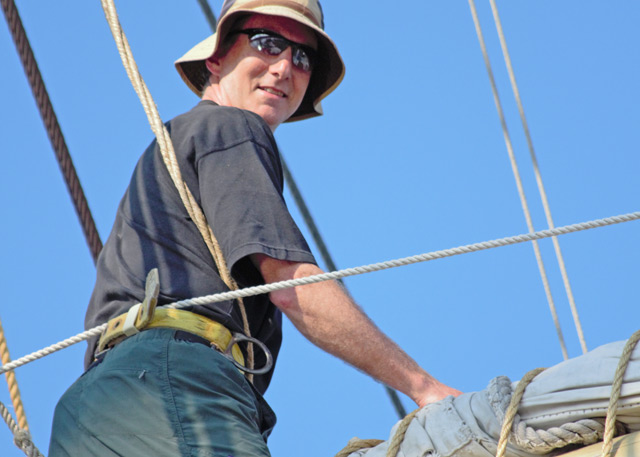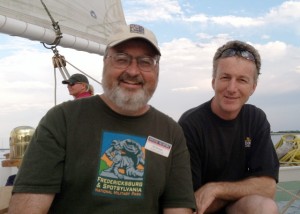5 Questions with . . . William “Vijay” Pinch on Maritime History

In this issue of The Wesleyan Connection, we ask “5 Questions” of William “Vijay” Pinch, professor of history. Pinch spent five weeks this summer interacting with maritime scholars and working in the archives and library at Mystic Seaport.
Q: What were you studying at Mystic Seaport this summer?
A: From June 25 to to July 27, I was privileged to be a student in a “summer institute” at Mystic Seaport, focused on “The American Maritime People.” The institute is usually pitched to graduate students, but every few years it is offered to college and university faculty with support from the National Endowment for the Humanities. This was one of those NEH-funded summers. The faculty who teach at the institute represent some of the top scholars in maritime history, especially in the context of the Atlantic and (mostly) North American world. What was especially interesting to me, as someone who was not originally trained in maritime history (or North American history for that matter), was to see how the field of maritime history has broadened, so that it now encompasses everything under the rubric of the human interaction with and perception of the sea over time. This appealed to my wider world-historical instincts. Similarly, it was instructive to see the ways in which the maritime experience mediated New England’s interaction with other parts of the Americas and the wider world. We also examined marine environmental history, fisheries history, the history of oceanography, naval history, and the recent maritime past and maritime present–including the geo-strategic challenges on the horizon (especially in the Pacific and Indian Oceans), the rise of container shipping, bulk cargo supertankers, and the mega-cruise ship phenomenon.
Q: How does this inform, or how is it informed by, your other areas of interest?
A: My initial interest in the summer institute at Mystic stemmed from a desire to refine and improve my maritime world history course. I’ve offered the course in varying incarnations over the past seven years or so, and each time I struggle with what to include and how to organize it. So the five-week course was excellent for stimulating new thinking along these lines. I’d like for students to be able to take better advantage of all that Mystic and the wider region have to offer. What makes the summer institute special is the combination of traditional classroom learning with more hands-on “public history” kinds of activities. We were able to see and interact with the stuff of the maritime past and work in the archives and library of the seaport. We read ships logs and diaries and memoirs; we examined scrimshaw and ships models and paintings and figureheads; we picked over lots of different boats (in addition to the boats on display, we wandered around in the boat warehouse where hundreds of old boats of all sorts are stored); we, of course, studied (and explored around in) the Charles W. Morgan, the last remaining wooden whaleship in the world, which is now in the seaport’s preservation shipyard undergoing a complete restoration (the process of restoration is itself worth studying); we learned how to climb the rigging on a tall ship (the Joseph Conrad, of Alan Villiers and “Stormalong” fame), and the more foolhardy among us even went up a second time to furl the sails from the fore and main topsail yards. We also were able to visit nearby sites of interest, including the Mashantucket Pequot Museum, UConn’s Maritime Studies Program at Avery Point, and Connecticut historic sites in New London and Groton, Stonington, and Newport, R.I.

Q: What did you gain from this experience?
A: From an experiential teaching point of view, the experience was invaluable. But the five weeks were also stimulating from a research perspective. I’m hoping, eventually (once I wrap up some current projects), to do more in-depth reading and writing on the significance of the sea in the long sweep of human history. The past decade has seen some fascinating new work in this area from disciplines as wide ranging as anthropology, paleontology, geography, history (especially environmental history and history of science and technology), and literary studies. In fact, some of this new scholarship is being produced by scholars who are faculty on the summer institute program–like Helen Rozwadowski and Jeffrey Bolster–so we not only got a first-hand view of the new work, we also learned the historiographical “back story” to the scholarship. I’d like to put some reflections about these new directions on paper at some point.
Q: What were your other goals?
A: An additional goal for the summer was to contextualize what I’ve learned over the years about the Connecticut River and Middletown’s own water landscape and maritime past, which was among the themes we explored last year at the College of the Environment’s “Think Tank.” Not surprisingly the history of Middletown shares a great deal with the story behind the creation of Mystic Seaport. The shift from merchant shipping to early industrial manufacturing is a region-wide story in which Middletown deserves a larger profile, but also fascinating is the interaction of native populations and Europeans on what one bright young historian (and former Mystic-Williams student) is calling the “salt water frontier” of southern New England and Long Island Sound. Finally, I was hoping to find connections at Mystic to my own longer-standing area of interest, South Asian history. I was not disappointed: Mystic Seaport, though it calls itself the “Museum of America and the Sea,” could easily call itself the “Museum of America and the World.” The maritime links that developed between New England and Asia–especially East Asia, but also South Asia and the wider Indian Ocean region–were especially important for the history of this region, and they are reflected in the objects on display at the Seaport Museum and in the printed documents, manuscripts, ships logs, artwork, and other objects housed in the seaport’s Collections and Research Center. I was only able to scratch the surface of all this, but there are some tantalizing possibilities for future research.
Finally, I gained a stronger appreciation for southeastern Connecticut–the New London/Groton/Mystic/Stonington area. It has a very different feel from Middletown, mostly due to its active working waterfront and the much stronger local appreciation for the importance of the region’s maritime heritage. So it was not surprising to see the wealth of talent and institutional energy directed toward maritime history in the area, at Mystic and beyond.
Q: You will be spending much of your sabbatical in India researching a new book. What can you tell us about it?
A: This year I’ll be in India as a “Fulbright-Nehru” senior research scholar, based in New Delhi. For four or five years now I’ve been working on the Mutiny-Rebellion of 1857, especially as it was experienced from below. There has, of course, been an outpouring of scholarship over many generations on “The Mutiny” or “Sepoy Mutiny,” as it was known. In the mid- and late-19th century, most of this work was written from the British imperial perspective. With the rise of Indian nationalism in the late-19th century, historians increasingly examined the event from the Indian point of view–some historians refer to it as India’s “first war of independence.” However, regardless of perspective, the writing tended to perpetuate a kind of “race war” approach. There are, of course, good reasons for this, as the events of 1857 were inordinately bloody and brutal, and did feature Indians and Britons killing each other in droves. But the conflict also involved Indians fighting and killing Indians–since many Indians remained “loyal to their salt”–and also many Indians coming to the aid of Britons in extremis. In fact, given the demographic realities of the British Empire in Asia, it was necessarily Indians who kept the British Empire alive in this time of crisis. And there were also lots of “mixed-race” people caught in the middle, “Anglo-Indians” and “Eurasians” of various kinds (these terms themselves evolve during the century in revealing ways). So my book will examine this “Civil War” side of the Mutiny-Rebellion, something that has not really been investigated to any great degree. Among the groups that I’m interested in are soldiers, of course, but also more historiographically marginal groups like prostitutes and ascetics–though the terms “prostitute” and “ascetic” don’t really capture the significance, subtlety and range of these professional identities.

